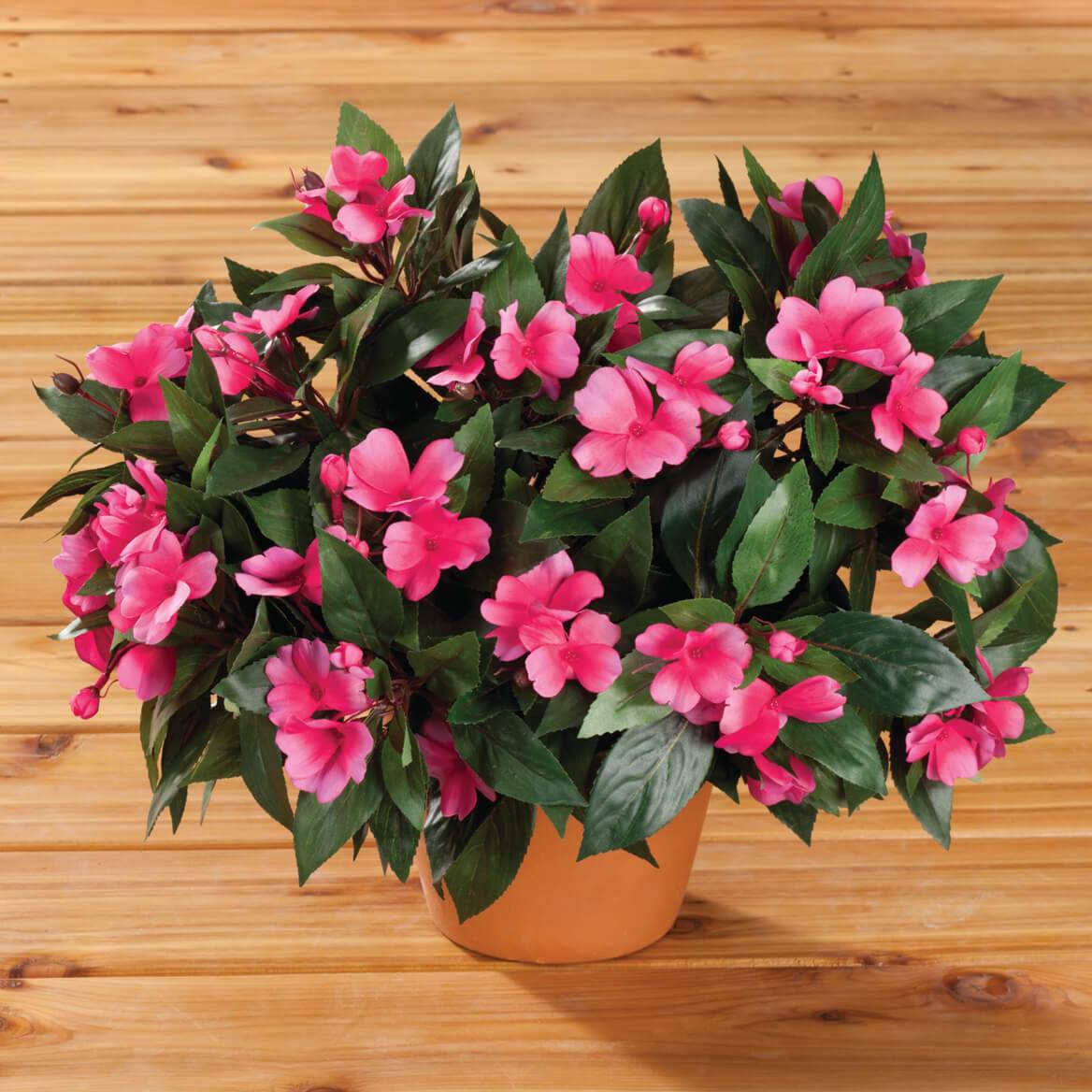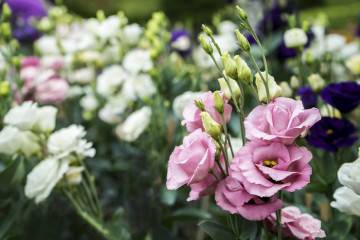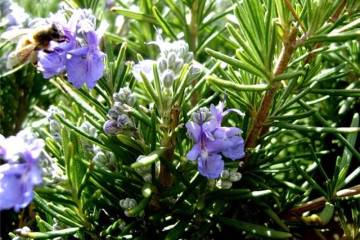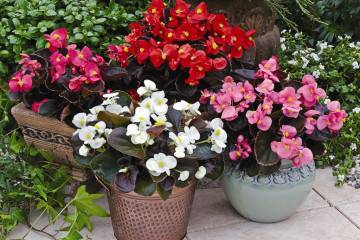Garden balsam - growing in a flower bed
Content:
- Garden balsam - what kind of flower is it, what family it belongs to
- Varieties of plants, popular varieties for growing in the country, what they look like
- Planting garden balsam in the open field
- Balsams - growing and care in a flower bed
- Can garden balsam be grown at home
- Features of flowering plants
- Flower reproduction methods
- Balsam - diseases and pests
The predominant place for sowing garden balsam is a flower bed, as well as outdoor flowerpots and flowerpots. Almost the entire growing season, a lush bush pleases with incessant flowering, for which it is appreciated by gardeners. Modern varieties are also suitable for planting in indoor pots.
Garden balsam - what kind of flower is it, what family it belongs to
The Latin name of the flower is Impatiens, which means "touchy". The fact is that when the ripe seed pods touch, they crack and discard their contents around. The bush with a conical crown is abundantly covered with flowers that bloom continuously from May to September, and in indoor conditions until December. Usually cultivated as annual balsam. Among the numerous species there are erect, ampelous and ground cover.
Brief description, history of origin or selection
In our country, a second, popular name, "Vanka wet", has been assigned to the garden species. Plants have the ability to secrete droplets of sweet juice on the leaves and stems that attract insects. For more than a hundred years in our country, the flower has been grown in the open field, as well as on window sills.
In Europe, the plant came into vogue over 500 years ago, becoming extremely popular among the aristocracy. Over time, bushes could be found not only in the closed private gardens of fashionistas, but also on the windows of ordinary townspeople.
The fashion for garden balsam came to Russia in the 19th century. Intensive selection was carried out in the XX century in order to obtain varieties adapted to growing in the open field of the middle lane. In parallel, varieties of various shapes and colors were bred.
Varieties of plants, popular varieties for growing in the country, what they look like
To your taste, you can choose a variety of any color from white to rich burgundy, almost black. All varieties are divided into dwarf ones - up to 15 cm high (for borders and pots), and tall - up to 50 cm high and above, suitable for flower beds.
Camelia Flowers
A fairly tall variety, bushes up to 50 cm high. The color of petals on corollas up to 4 cm in diameter from white to deep pink, red. The bush is highly branched, the shoots are fragile. Leaves are green, narrow, lanceolate, with a serrated edge. Single buds are formed on the shoots between the pairs of leaves.
Tom Tumb
It differs from others in thicker fleshy shoots and very large flowers. From each axil of green leaves with jagged edges, buds of red, white, purple, pink double flowers up to 4-5 cm in diameter peep out.
Baby bush
A very many-sided variety, characterized by low growth - up to 20-25 cm. Flowers can have a simple shape or semi-double, and various colors. The leaves are wider, close to heart-shaped, dark green without pubescence.
Planting garden balsam in the open field
The modern varieties, which are commercially available from various seed producers, are excellent for outdoor cultivation all the way to the northernmost regions. Of course, where summer comes late, only the seedling method is used.
Location selection
Touch-me-not loves the sun, but withstands partial shade well. Depending on the region of sowing, you can assign it a site on the sunniest flowerbed (Moscow region and the middle strip), or in partial shade - Stavropol, Krasnodar Territories.
How to prepare the soil and flower for planting
For cultivation, soil with a light structure is suitable, into which compost must first be added. On soil poor in organic matter, flowering will be much more modest. Before sowing, you should not only dig up the area, but also loosen, remove weeds.
Balsams - growing and care in a flower bed
In general, caring for an annual is almost the same as for other decorative flowering crops.
Watering rules and humidity
Vanka loves wet wet, otherwise he begins to dry. Watering is required regularly, but not too abundant. With an excess of moisture in the soil, the roots can rot, and fungal diseases also appear. If the weather is hot and dry and the tips of the leaves begin to wither, then it is better to water twice a day, but little by little.
Spraying the bushes is not required, as it leads to damage to foliage and flowers, he can throw them off. When watering, water is poured strictly under the roots. Balsam fades, what to do - water!
Top dressing and soil quality
If in the fall the soil has been carefully dug up and humus is introduced, then in the spring you do not need to add anything. If the soil is poor in organic matter, then watering with the addition of humate is recommended, which is carried out at a frequency of 1 every 2 weeks to maintain lush flowering. Potash and nitrogen mineral dressings have a positive effect on flowering.
Pruning and replanting
During the summer, only those shoots on which traces of diseases are found are cut off. Withered flowers are regularly plucked so that they do not spoil the appearance of the bush. In autumn, in regions with negative winter temperatures, bushes can be dug up and transplanted into pots. At home they are kept at temperatures above +6 ° C.
In the spring, the crown of a perennial is shortened by 2/3, and then planted again in open ground at the end of May. Seedlings of some varieties are pinched when transplanted into open ground, but more often this is not required.
Features of winter care
The optimum temperature for winter maintenance is +10 ° C. Watering at this time is carried out very rarely, in order to only maintain the viability of the roots. But in winter, the bushes must be displayed on well-lit windowsills.
If balsam is kept at + 16-18 ° C in winter, then flowering will not stop. But watering still needs to be limited, since due to the short daylight hours, the growth rate will noticeably decrease. Fertilizers during this period are applied in a half dosage once a month.
Can garden balsam be grown at home
In the room, he is assigned the brightest window - south or east. With enough light, the bush can bloom all year round. It is worth buying seeds for indoor cultivation marked "perennial balsam".
Garden balsam - planting and care
Sowing seeds is carried out in late February - early March.
At a temperature of + 18-20 ° C, seedlings appear in 3-7 days. The pick is carried out at the stage of 2-3 true leaves. Pots are chosen for young plants with a diameter of 6-7 cm.
The soil is suitable for roses, violets, as well as universal with neutral acidity.Rippers are introduced into it: peat, vermiculite, perlite, sand, achieving good looseness and air and moisture permeability.
Water the plants in pots after the soil dries up to half the height of the pot. Top dressing is carried out once every 2 weeks with a complex fertilizer for indoor flowering plants, for example, Agricola. The optimal duration of lighting is 10-12 hours per day. Under such conditions, flowering will begin in May and will last until December.
Features of flowering plants
The beauty of the plant is that its flowering does not stop for almost six months. As soon as some corollas fade, new ones immediately bloom to replace them. The forcing of buds stops only when there is a lack of light or nutrients in the soil.
A period of activity and rest
The first flowers when sown for seedlings at the end of February will appear in the second half of May. Further, the bush in the open field will bloom until the first frost, and at home - until December. Artificial lighting up to 10-12 hours will help to make it year-round.
Types and shape of flowers
Corollas are found in all kinds of shades, both monochromatic and multi-colored. They are simple, semi-double and terry. Outwardly, they are often very similar to miniature roses, and in some varieties, to tiny orchids.
Flower reproduction methods
In addition to traditional seed sowing, excellent results are obtained by propagation of favorite varieties using cuttings, as well as layering.
Propagation by apical cuttings
Twigs from the tops of about 5 cm long are suitable for cuttings. 3-5 leaves are left on each. Cuttings are placed in cups of water in a shaded place. The roots should appear in 7-10 days. After that, the twigs are planted in open ground or a pot, where they are looked after as if they were adult plants.
Reproduction by layering
If we are talking about an ampelous variety, then its whips can be easily dug into the soil nearby to get new plants. The roots will appear in 10-15 days, but you should not cut off the whip right away. Why it is not worth doing this: it is more effective to wait another 7-10 days, and then cut a new bush from the mother, dig up the roots and plant it immediately in a new place.
Balsam - diseases and pests
Of the garden pests, the greatest damage is caused by aphids, whiteflies, spider mites, ants, literally attacking flowers. Against them, it is necessary to carry out treatment with insecticides, for example, Fitoverm, once every 2 weeks. Diseases of balsam arise due to waterlogging of the soil, so it is worth adjusting the watering, and if necessary, you can fight with fungicides, for example, HOM.
The nibbled edges of the leaves indicate an invasion of snails. Usually they sleep near the ground during the day, and crawl onto the stems at night. They can be collected by hand and taken out of the site. Sprinkling the soil around the flowers with wood ash will help scare off the snails.
Balsam in the garden is a beautiful and unpretentious plant that has spread all over the world, thanks to its rich palette of colors and very long flowering. A favorite variety, for example, New Guinea, can be easily planted and grown in the open field, and in the fall it can be dug up and brought into the house to admire the flowers until December.




















